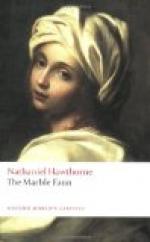Over and over again, there was the idea of woman, acting the part of a revengeful mischief towards man. It was, indeed, very singular to see how the artist’s imagination seemed to run on these stories of bloodshed, in which woman’s hand was crimsoned by the stain; and how, too,—in one form or another, grotesque or sternly sad,—she failed not to bring out the moral, that woman must strike through her own heart to reach a human life, whatever were the motive that impelled her.
One of the sketches represented the daughter of Herodias receiving the head of John the Baptist in a charger. The general conception appeared to be taken from Bernardo Luini’s picture, in the Uffizzi Gallery at Florence; but Miriam had imparted to the saint’s face a look of gentle and heavenly reproach, with sad and blessed eyes fixed upward at the maiden; by the force of which miraculous glance, her whole womanhood was at once awakened to love and endless remorse.
These sketches had a most disagreeable effect on Donatello’s peculiar temperament. He gave a shudder; his face assumed a look of trouble, fear, and disgust; he snatched up one sketch after another, as if about to tear it in pieces. Finally, shoving away the pile of drawings, he shrank back from the table and clasped his hands over his eyes.
“What is the matter, Donatello?” asked Miriam, looking up from a letter which she was now writing. “Ah! I did not mean you to see those drawings. They are ugly phantoms that stole out of my mind; not things that I created, but things that haunt me. See! here are some trifles that perhaps will please you better.”
She gave him a portfolio, the sketches in which indicated a happier mood of mind, and one, it is to be hoped, more truly characteristic of the artist. Supposing neither of these classes of subject to show anything of her own individuality, Miriam had evidently a great scope of fancy, and a singular faculty of putting what looked like heart into her productions. The latter sketches were domestic and common scenes, so finely and subtilely idealized that they seemed such as we may see at any moment, and eye, where; while still there was the indefinable something added, or taken away, which makes all the difference between sordid life and an earthly paradise. The feeling and sympathy in all of them were deep and true. There was the scene, that comes once in every life, of the lover winning the soft and pure avowal of bashful affection from the maiden whose slender form half leans towards his arm, half shrinks from it, we know not which. There was wedded affection in its successive stages, represented in a series of delicately conceived designs, touched with a holy fire, that burned from youth to age in those two hearts, and gave one identical beauty to the faces throughout all the changes of feature.




